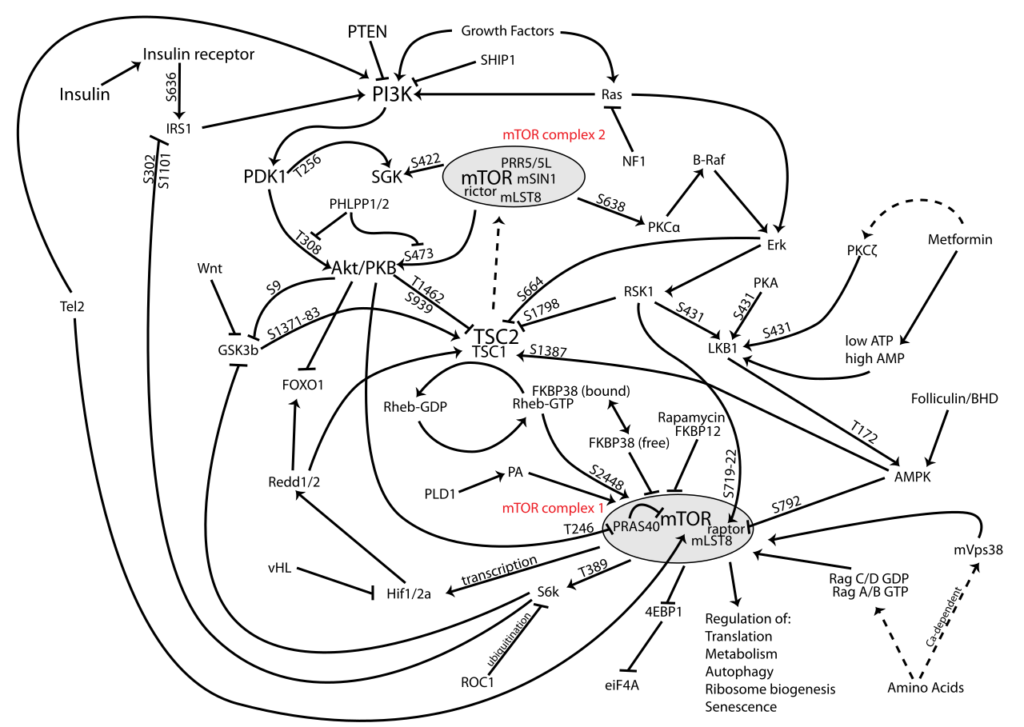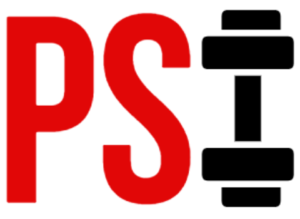The human body is an incredibly complicated piece of biological machinery.
Below the seemingly simple and idle surface lies a lively and complex organism that carries out thousands of processes every day.
Thanks to the many hormones, cells, neurotransmitters, impulses, and more, the body does its thing in the background, and we get to live a seemingly simple life. At least, in comparison to what happens within us every day.
One fascinating aspect of our physiology are metabolic pathways.
Today, we’ll be taking an in-depth look at one of these pathways – mTOR (the mammalian target of rapamycin). Specifically, we’ll go over what it is, how it impacts us, and what we can do to help it work better for us.
A Brief Primer on Metabolic Pathways
In biochemistry, a metabolic pathway is a linked series of reactions within our cells that work toward a specific outcome. In most cases, one reaction produces the ‘ingredient’ for the following one, and the by-products that come out typically get escorted out of cells and discarded as waste.
Enzymes that play vital roles in metabolic pathways often need nutrients such as vitamins and minerals to work well. This is one reason why following a healthy and balanced is so important: it provides the body with the building blocks it needs to perform its many tasks.
There are three major metabolic pathways in the body: anabolic, catabolic, and amphibolic.
An anabolic pathway requires energy to build and create. For example, muscle growth is possible thanks to anabolic pathways. A catabolic pathway is the opposite: a chain reaction of events resulting in a net release of energy for use. For example, muscle protein breakdown is one way the body can break itself down to release energy.
An amphibolic pathway is even more interesting because it can be catabolic or anabolic, depending on the body’s needs and how much energy it has available.

mTOR Pathway 101 – What is It?
The mTOR pathway (also known as the primary hypertrophy pathway) is a central piece of mammalian metabolism and physiology. Specifically, mTOR serves as a regulator and oversees many processes that concern muscle and fat tissue and organs such as the brain and liver. The pathway is vital for growth, development, and survival.
According to some research, conditions such as diabetes, depression, and certain cancers interact with mTOR (1, 2, 3).
Interestingly enough, nutrient surpluses and deficiencies can impact the mTOR pathway in different ways (4). Any indication of energy deficiency (such as while dieting) can inhibit the mTOR pathway. This is one significant reason why muscle growth becomes incredibly difficult (impossible even) while losing fat.
Specifically, energy deficiencies activate the AMPK pathway, which is one way to inhibit mTOR signaling (5).
Glucose deprivation (such as on a ketogenic diet) can also lead to mTOR inhibition, though this process sidesteps AMPK (6). The interesting part is, glucose deprivation can occur independently from creating a calorie deficit. In other words, you can be eating enough calories, but not eating enough carbs can directly inhibit mTOR.
In the same line of thought, insulin (through a chain reaction) can activate mTOR signaling. As we all know, carbs stimulate insulin release, which is one huge argument in favor of consuming carbs if your goals include muscle gain.
All of this makes evolutionary sense. In times of abundant food, it was only natural to add muscle and fat. Muscle is important because it makes us stronger, more functional, and better providers for our loved ones. Body fat, albeit not a fan-favorite, also plays an important evolutionary role because it serves as a storage of energy and allows us to live through food shortage periods.
When food is scarce, stress and an energy deficit hinder the mTOR pathway, preventing muscle development. The body creates a catabolic environment where it burns lean and fat tissue for energy.
In case you’re a bit confused, here is the gist of it:
The mTOR pathway plays a considerable role in our overall growth and development. Processes that hinder it also hinder muscle growth.
Interestingly enough, too much of a good thing can be bad. Research associates an overly-active mTOR pathway with an increased risk of obesity, cancer, depression, type 2 diabetes, and neurodegeneration. But, for the average person, this shouldn’t be a concern.
Are There Any mTOR Activator Supplements That Genuinely Work?
There are many “mTOR activation” supplements on the market. Supposedly, taking them helps purposely activate the mTOR pathway and accelerate our muscle-building efforts.
For example, phosphatidic acid (PA) is one contender in this category. In case you’re unfamiliar, phosphatidic acid is a group of phospholipids that serve an essential role in cell signaling. PA appears to play a direct role in mTOR regulation, though the mechanisms behind this effect remain to be understood.
Some would go as far as to suggest that PA essentially ‘turns on’ muscle protein synthesis through mTOR, but research doesn’t seem to suggest that. Sure, it appears to be necessary. But it alone cannot dictate the rules of our physiology.
For example, one study looked at the direct effects of different PA precursors and phospholipids, how they impact the mTOR pathway, and how that translates to the adaptations we experience from training (7). In other words, does PA lead to better results or not?
A total of 28 subjects between the ages of 18 and 24 were given 750 mg of PA daily or a placebo. They also took part in an eight-week resistance training program. The results were impressive:
PA significantly activates mTOR and significantly improved responses in skeletal muscle hypertrophy, lean body mass, and maximal strength to resistance exercise.
A few years ago, researchers from California State University came out with an exciting study regarding PA (8). Eighteen healthy and strength-trained men were the subjects. Eight of the subjects received the supplement (phosphatidic acid, leucine, HMB, and vitamin D3), and ten were given a placebo.
All of the participants also completed three weekly resistance workouts for eight weeks.
Here’s the interesting bit:
The subjects that took the supplement experienced greater lean mass gains and improved strength in the leg press and bench press.
Another study showed similar results (9). In this one, sixteen subjects were either given 750 mg of PA daily or a placebo. Each subject also had to complete four resistance training workouts per week for eight weeks.
The subjects that took PA saw a 12.7 percent increase in squat strength and a 2.6 percent increase in lean mass. On the other hand, the placebo group saw 9.3 percent improvements in squat strength and a mere 0.1 percent improvement in lean mass gains.

These are certainly some exciting studies, and we should see more research in the future. Who knows? Phosphatidic acid may turn out to be an incredible compound for improved mTOR signaling and superior muscle and strength gains.
Still, it’s worth noting that we shouldn’t place too much stock into these studies mostly because they are short-term. Each of these trials lasts for eight weeks. We are yet to understand whether PA is safe in the long run, whether we can expect to stimulate mTOR for a longer period, and whether this stimulation would result in superior results down the line.
For example, these studies suggest that folks who take PA see more significant gains in strength and lean mass gains. But, we can’t be sure whether this would be the case after three, six, or nine months. How about after one year?
There is one more interesting supplement worth looking at today: leucine. In case you’re unfamiliar, leucine is an essential amino acid, and the scientific community largely regards it as the most important one for muscle protein synthesis. In fact, according to research, leucine alone is powerful enough to kickstart protein synthesis.
An interesting study from 2010 looked at exogenous leucine administration on mTOR signaling and amino acid transporters (10). They found it to be a vital component of the mTOR pathway:
“mTOR signalling is transiently activated by leucine within human myotubes independently of insulin stimulation.”
Despite being an in-vitro study, it does shed light on one fundamental truth: leucine is vital for protein metabolism, growth and can even reverse catabolism. Other research has also had similar findings (11, 12).
But here is the thing:
Many marketers have jumped at the opportunity to claim that their BCAA or other leucine-related supplement helps activate the mTOR pathway, which would theoretically lead to more muscle growth.
The problem with this line of thinking is that none of the research suggests that we need to get leucine in an isolated form (i.e., from a supplement) for it to work. We are just as likely to get the same effect by having some leucine from a protein-rich meal.
In other words, saying that a given supplement activates mTOR is like saying that a sports drink helps keep people hydrated. Sure, but it doesn’t mean that we can’t achieve the same outcome through simpler and less expensive options – for example, by having a glass of water instead.
Still, leucine supplementation can be beneficial and could help prevent excessive muscle protein breakdown. For example, if you train in a fasted state, having some leucine before or right after your workout can stimulate protein synthesis to a degree and prevent too much catabolism.
The Bottom Line On Supplements and mTOR
Given that the mTOR pathway is highly susceptible to nutrients and energy availability, it’s not a stretch to assume that many supplements on the market can stimulate it. For example, since leucine stimulates mTOR signaling, other leucine-containing products such as whey protein powder also stimulate it.
Also, since carbohydrate availability (independent from overall energy availability) also seems to impact mTOR, we can assume that carbohydrate-rich supplements like weight gainers can also stimulate mTOR signaling, especially if we are otherwise on a low-carb diet.
But we have to consider two problems here:
First, would this temporary boost in mTOR signaling result in more muscle growth over time? After all, this is the objective here, and nobody is interested in activating mTOR just for the sake of it.
Second, would we be able to achieve the same effect through food? For example, instead of consuming leucine, could a protein-rich meal deliver the same (if not better) outcome?
It’s mostly guesswork at this point because research is yet to catch up here. So far, the only supplement that does show some promise is phosphatidic acid. But even there, research is still in its infancy, and we need long-term research regarding PA’s overall safety and efficacy before concluding.
Suggestion: If you are looking for a muscle building supplement, check out this article on Apigenin. It’s another great article on Pump Some Iron.

Are There Other Ways to Purposely Activate the mTOR Pathway?
So far, there are a handful of things that are associated with mTOR stimulation. Most notably:
1) Protein
Protein is arguably the essential nutrient we need to get if we want to grow and develop. According to experts and research, protein (especially if it’s rich in the amino acid leucine) stimulates mTOR signaling and kickstarts muscle protein synthesis.
So, it’s crucial to consume enough protein every day. According to some research, we need around 0.8 grams of protein per pound of body weight daily (13). For example, if you currently weigh 200 lbs, that would be a daily goal of about 160 grams of protein.
You can bump that number to around one gram per pound of body weight while dieting to lose weight, but it shouldn’t make much of a difference.
Besides that, some of your daily protein should come from meat, poultry, fish, and dairy, as they are richer in leucine.
2) Abundance of calories
Another rather obvious activator of the mTOR is the abundance of calories. This makes a lot of sense from an evolutionary standpoint because the body’s primary goal is survival. If there aren’t enough calories, it won’t initiate the metabolically-costly processes of building and maintaining muscle tissue.
So, it’s important to consume enough calories. Eating around maintenance is great for keeping your muscle mass. But, if you want to grow optimally, you should be in a calorie surplus (14).
3) Carbohydrates and the hormone insulin
As we mentioned earlier, the lack of carbohydrates can hinder mTOR signaling even if we are otherwise eating enough calories every day. For that reason (and many others), it’s not ideal to attempt building muscle mass without consuming enough carbs.
This effect is most likely thanks to the hormone insulin. While fats and protein are both insulinogenic, they don’t come close to the impact carbs have on insulin levels. For example, in one study, researchers looked at mTOR’s role in insulin signaling (15). They concluded:
“A postprandial increase of insulin and glucose acutely activates mTOR within metabolic tissues, in which mTOR plays an important role in glucose and lipid metabolism.”
So, it’s crucial to consume enough carbs to keep mTOR active and muscle growth on track. You can do this by having a consistent amount of carbs every day or cycle them every few days like you would on the Anabolic Diet (five low-carb days, followed by a two-day carb refeed).
4) Physical activity
Physical activity is a stressor. At its core, exercise causes a disruption, forcing the body to adapt by becoming bigger and stronger.
For example, lifting weights is profoundly stressful and disrupts the body on numerous levels. This forces the body to recover and grow itself stronger, so it can more easily handle this same stressor more easily, and without allowing it to cause the same level of disruption.
For that reason alone, it shouldn’t come as a surprise that physical activity stimulates mTOR signaling (16, 17).
But, physical activity is only beneficial when taken in the right amount. Doing too much work can lead to overtraining, which can swing the pendulum in the other direction and lead to muscle loss, fatigue, demotivation, and more.
There are plenty of recommendations for training volume out there, but most research suggests that we should do more than ten weekly sets per muscle group if our goal is muscle growth (18).
5) Testosterone
Testosterone is well-known as one of the most critical anabolic hormones within the body. The hormone is so powerful that mere administration beyond the physiological range is enough to cause gains in lean tissue (19). It’s only natural that testosterone impacts mTOR signaling significantly.
Beyond the use of PEDs and various ‘testosterone-boosting’ substances, the best ways to optimize our testosterone levels are:
- Practice regular strength training, but avoid doing too much to the point of running into recovery issues;
- Consume a calorie-controlled and balanced diet that contains enough protein, carbs, fats, vitamins, and minerals;
- Get enough sleep. Seven hours per night will be great; eight will be even better.

Should We Worry About Things That Potentially Hinder mTOR?
There are many mTOR pathway inhibitors – for example, medications such as tacrolimus and temsirolimus. They are typically used as immunosuppressants and can hinder mTOR.
Another common example here is intermittent fasting. The practice has become incredibly popular in recent years, but it activates AMPK and hinders the mTOR pathway. As we saw above, low-carb dieting can also inhibit mTOR signaling.
The question here is, should we worry about these things?
Sadly, it’s difficult to say how these temporary impedances of the mTOR pathway would impact our gym results because we don’t have any data.
It’s also worth noting that, even if they do hinder growth, to what extent? Would it matter in the grand scheme of things?
So far, we can mostly rely on our best judgment and ask ourselves, “Objectively speaking, how would this practice impact my muscle-building efforts?” For example, not eating for 16 and 20 hours every day are both examples of intermittent fasting. But, who could argue that they would have the same effects on us? Fasting for sixteen hours a day might be okay. But going for twenty hours without food each day? Well, you would be treading on thin ice.
Another example here is a caloric restriction: a well-known mTOR inhibitor. A small deficit of 100 to 200 calories per day might not severely impact the mTOR pathway, especially if the person is overweight. In fact, people still might be able to build muscle with such a deficit, albeit more slowly.
But a 1000-calorie deficit? Well, now we are talking about something different entirely. Even most beginners wouldn’t be able to see significant muscle growth with such an energy deficit.
Still, none of this is to say that things that inhibit the mTOR pathway are necessarily wrong. The truth is, most are inevitable parts of life and fitness, and we can’t avoid them. To give you caloric restriction as an example again:
Sure, it inhibits the mTOR pathway. But who could argue that being in a deficit from time to time isn’t beneficial for us? The truth is, dieting is a natural part of building a good physique. We can’t remain in an energy surplus indefinitely. At some point, we need to trim down the accumulated body fat and give ourselves room to grow more.
So, the bottom line is this:
It’s a gray area, and we need to think long and hard about everything. Certain things (such as following a 20:4 fasting protocol or a ketogenic diet) will probably not bring any muscle-building benefits. But, the occasional energy restriction (despite leading to mTOR inhibition for a time) is necessary.
Conclusion
It’s difficult to ignore the mTOR pathway. Whether we like it or not, it works in our lives’ background and dictates change and improvement.
Sadly, research relating to the mTOR pathway, especially as it applies to our fitness results, is still in its infancy.
Instead of worrying too much about it, we should focus on what we know and what research suggests. Who knows? We might have a lot more data in a couple of decades that would allow us to make much more informed decisions.

